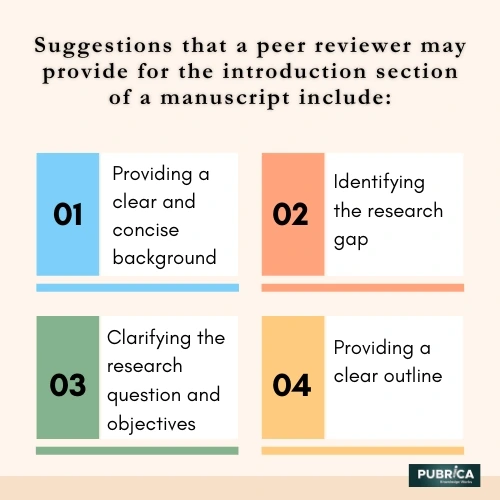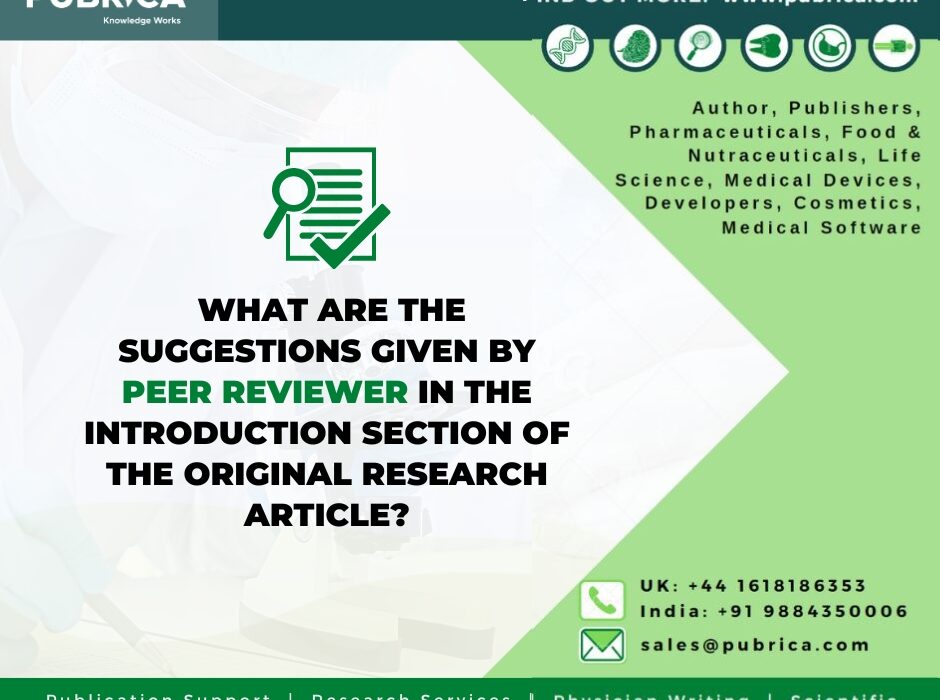
Guidelines for Addressing to Reviewers’ Comments
August 21, 2023
Understanding Incidence and Prevalence in Toxicology: Biostatistics and Epidemiology Principles
September 8, 2023What Are the Suggestions Given by Peer Reviewers in the Introduction Section of the Original Research Article?
Suggestions Given by Peer Reviewers in Original Research Article
A paper’s success in publishing is determined by several factors. First, the editor/subeditor checks the paper for completeness, adherence to the journal’s style, and compliance with institutional ethics. The original research article is then circulated through the editorial board for an internal review of relevance, ethics, and methodology. The board members may reject the manuscript if it is unsuitable for the journal’s readership or has significant ethical or methodological flaws. After passing the internal review process, the manuscript is sent for an external review by peer reviewers.
Introduction Section Review Suggestions
The introduction section of the research article shows promise, but there are some suggestions to enhance its impact.
- Firstly, consider framing the research problem more explicitly and engagingly, outlining its relevance from the outset.
- Secondly, provide a concise overview of the field’s current state to contextualize the research objectives. Adding recent key references could support this.
- Thirdly, ensure a clear and gradual buildup to the research gap, highlighting its significance in addressing existing limitations.
- Lastly, streamline the articulation of qualitative and quantitative research questions to reflect their specific contribution. These suggestions aim to bolster the introduction’s clarity, setting a strong foundation for the study and captivating readers’ interest from the outset.
Who can be a reviewer?
A reviewer must have published at least five original research papers to understand medical writing and the peer review process. The editor invites a scholar or academician with expertise in the same topic or a well-known authority. Reviewers are asked to provide their expertise using keywords on the manuscript management website. Journal publications often have a database of potential reviewers; the editor can select reviewers using keywords. Researchers can send their curriculum vitae to specific journals and request empanelment as potential reviewers. Being a reviewer is considered an honour, privilege, and duty for researchers, and one should not refuse to review a paper if they have the expertise and can spare time to complete the review.
Some suggestions that a peer reviewer may provide for the introduction section of a manuscript include:

- Providing a clear and concise background: The peer reviewer may suggest adding more context to the introduction to help readers understand the research question and its importance. For example, the reviewer may suggest providing a more detailed description of the problem the research aims to address.
- Identifying the research gap: The reviewer may suggest that the author identify the literature gap and explain how their research will address it. For example, the reviewer may suggest that the author provide more context on why the research is needed and how it will contribute to the field.
- Clarifying the research question and objectives: The peer reviewer may suggest that the author provide a clearer and more concise research question and objectives directly related to the research gap identified in the literature.
- Providing a clear outline: The reviewer may suggest that the author provide a clear and concise outline of the manuscript’s structure, including what will be covered in each section.
Example:
A peer reviewer may comment, such as, “The introduction provides a good overview of the research topic but could benefit from more detailed background information to help readers understand the study context. Additionally, the research gap could be more clearly identified and linked to the research question and objectives. Finally, the author may want to consider providing a clearer outline of the manuscript structure to help readers navigate the paper more easily.”
- Check out our sample original research article examplesto see how the original research article sampleis structured.
Recent concepts
- Some journals have begun utilizing a “postpublication” approach, in which the peer-reviewed and accepted article is uploaded on the internet before the paper’s publication; readers may then leave comments on the document, which can be published alongside the reader’s remarks. The “light touch peer review” strategy, which focuses on the process, has become popular in many open-access journals.
- Some publications include timelines online (as a weblink) with the journal article in addition to publishing the peer reviewer comments or the whole “prepublication history” (uploaded versions, reviewer’s reports, and author responses). In certain journals, a revised manuscript draft is placed online for review by the academic community, and after a set amount of time, the revised draft paper is approved for publication.
- Useful guidance on ethics of publication and peer review is available on the COPE (Committee on Publication Ethics) website (https://publicationethics.org/resources/guidelines-new/cope-ethical-guidelines-peer-reviewers), and authors, reviewers, and editors need to be acquainted with these.
Conclusion
The peer reviewer’s input on the introduction of the original research article was crucial. Their suggestions improved the research objectives and study significance, prompted a refinement of the literature review, and highlighted the importance of succinctly stating the research gap and questions. These suggestions enhanced the research article’s academic rigour and ability to engage and inform readers effectively. The reviewer’s insights have significantly improved the overall clarity of the introduction.
About Pubrica
Pubrica Has Professional Experience In Medical Writing. Further The Team Of Medical Professionals From Pubrica, Offer Unique Medical Writing Services Includes Clinical Research, Pharmacology, Public Health, Regulatory Writing, Clinical Report Forms (Crf), Biostatistics, Psychology, Life Science, Dentistry, Radiology, Dermatology, Diabetology, Gynecology, Cardiology, Biochemistry, Forensics, Surgery, Neurology, Psychiatry, Genomics, Medical Device, Pharmaceutical, Nutraceutical, Fmcg Companies, Hospitals, Universities, Publishers, PhD, Students Pursuing Medicine, Physicians, Doctors, Authors And Provide Support In Writing Any Medical Stream Paper.
References
- Yaddanapudi LN, Yaddanapudi S. An introduction to peer review. J Anaesthesiol Clin Pharmacol. 2015 Oct-Dec;31(4):437-9. doi: 10.4103/0970-9185.169047. PMID: 26702196; PMCID: PMC4676228.
- Tullu MS, Karande S. Peer reviewing an original research paper. J Postgrad Med. 2020 Jan-Mar;66(1):1-6. doi: 10.4103/jpgm.JPGM_492_19. PMID: 31898597; PMCID: PMC6970322.

14 years of expertise in clinical research with a doctoral distinction in life science.


